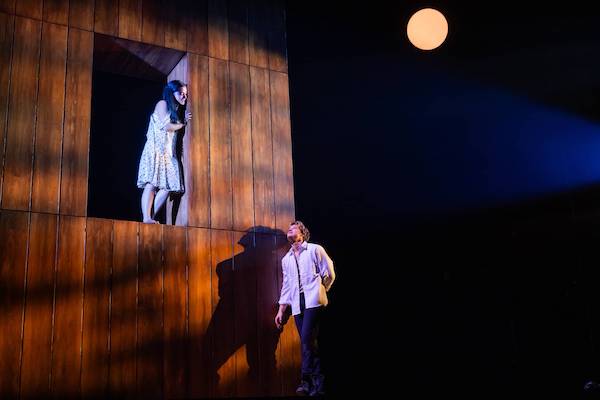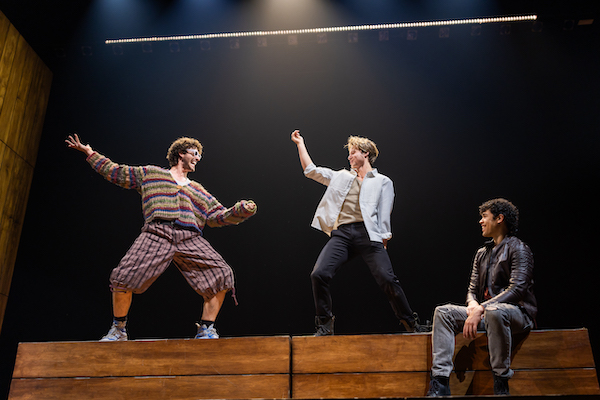Theater Review: A.R.T.’s “Romeo and Juliet” — What’s Love Got to Do With It?
By Bill Marx
Cinematic in inspiration, Diane Paulus’s direction whips up terse bursts of adolescent energy, tapping into a cocky hunger for self-destructive combat.
Romeo and Juliet by William Shakespeare. Directed by Diane Paulus. Choreography and movement direction by Sidi Larbi Cherkaoui. Staged by the American Repertory Theater at the Loeb Drama Center in Harvard Square, Cambridge, through October 6.

Emilia Suárez and Rudy Pankow in the American Repertory Theater production of Romeo and Juliet. Photo: Nile Scott Studios and Maggie Hall
In her welcome note to the American Repertory Theater’s production of Romeo and Juliet, Artistic Director Diane Paulus invites audience members to engage with an Essential Question: “In what ways do we define our lives through hatred? In what ways do we define our lives through love?” That’s two questions, but never mind. This engaging production is at its most satisfying when it grapples with the first. It is not as compelling when it takes up the second, especially when it attempts to ameliorate the toxic masculinity (Shakespearean version) and family dysfunction the staging puts on formidable display. The problem with looking at how “we define our lives through love” is that the tragedy contains so little of the latter, despite the celebrated couple at its center. Are Romeo and Juliet instant soul-entwined lovers or the casualties of lust? Are they adolescents steamrolled by infatuation? Or are they, as W.H. Auden argues, “idolators of each other, which is what leads to their suicides.” This staging accepts R & J’s romantic attraction at face value — and then some, via a Green New Deal coda — and it’s not enough to compensate for the Bard’s vision of meltdown.
Dramatically speaking, that is fine by me. Cinematic in inspiration, Diane Paulus’s direction whips up bursts of self-destructive adolescent energy, tapping into a cocky hunger for brawling that’s beautifully visualized through the choreography of Sidi Larbi Cherkaoui and fight consultant Thomas Schall. The stage has been cleared of any obstacles, aside from a huge moveable wooden block at its center. At one point, the monolith opens up to present the smallest balcony I have ever seen Romeo and Juliet canoodle on. Aside from those bouts of amorous claustrophobia, Amy Rubin’s smart set is ‘fight night’ effective. The omnipresent darkness of the background is punctuated by shining globes that suggest bottled moonbeams, humane sensibilities marginalized by brute force.
Love may be consigned to close quarters, but the expanse provides plenty of room for aggressive knife play, crotch-grabbing, and slip slides. Standouts include Alex Ross’s nicely nasty Tybalt and the macho chest-thumping of Terence Archie’s Lord Capulet. Their bullying brand of intimidation dominates the women in the play, who are also empowered, via Nicole Villamil’s Lady Capulet and Sharon Catherine Brown’s Nurse, to do some bossing around of their own. Law and order, solidly personified by Jason Bowen’s Prince, strikes condemnatory, but ineffective, postures. That said, I wish Clay Singer’s Mercutio was more modulated — the actor spews out his words so quickly, changes his vocal tone and persona with such head-spinning animation, that it undercuts the figure’s articulate antics. Overall, the delivery of the verse in the production tends toward the conversational rather than the lyrical, and that prosaic quality (which includes the costuming) keeps the hate humming along nicely. It also allows for some leavening humor.

Clay Singer, Rudy Pankow, and Brandon Dial in the American Repertory Theater production of Romeo and Juliet. Photo: Nile Scott Studios and Maggie Hall
As for the staging’s vision of love, that is defined more by earnestness than emotional depth. As the star-crossed lovers, Emilia Suárez and Netflix heartthrob Rudy Pankow come off as endearing, sympathetic victims of an insane feud — but their passion is never steamy or extreme. The pairing is cuter than it is combustible: Pankow remains an amiably smitten swain throughout, while Suárez takes fuller (and more adroit) advantage of Juliet’s maturing. Her rendition of the Act 3 speech (“Take him and cut him out in little stars,/And he will make the face of heaven so fine/That all the world will be in love with night”) hits the right languorous note. The role of Friar Laurence is expanded here — he delivers the opening words of the chorus and sums up the “tale of woe” at the end. Terrence Mann’s performance is so smoothly confident it irons out the cleric’s ambiguities. This Friar is an avuncular spirit of guitar-wielding, plant-loving tolerance. He may say “these violent delights have violent ends,” but he doesn’t believe it. (I sense a touch of smug liberalism here, but I may be wrong.) Too bad this enlightened Friar wasn’t with it enough to suggest that Juliet dress up as a guy and run off to exiled Romeo in Mantua.
All of this is potent, though the wind-up loses some punch because Paulus decided to tack on an ‘inspiring’ message. In Act 5, Romeo doesn’t duel with and kill Paris, his rival for Juliet. The guy doesn’t show up. Why? To cut the show’s running time? Lower the play’s body count? Make Romeo come off as less violent? Shakespeare knew the appetites of the groundlings well; he had to arrange a concluding burst of swordplay — a coup de théâtre in front of Juliet’s tomb. It would have been really interesting to see what Cherkaoui and Schall would have made of the grotesque confrontation. On top of that, Paulus’s new-agey Friar introduces a post-tragic vision of a ballooning “green acres,” an add-on that I hope never comes into directorial fashion. (Hey, let’s make everybody feel better and toss in a rainbow at the end of King Lear.) The Bard arrived at the utter wretchedness of the final tableau — promising youth as the victims of vengeance — intending that shaken theatergoers return, with that haunting image in mind, to their daily lives. Perhaps to pose this Essential Question: Why must youth (and women and children) be “poor sacrifices to our enmity”?
Bill Marx is the editor-in-chief of the Arts Fuse. For four decades, he has written about arts and culture for print, broadcast, and online. He has regularly reviewed theater for National Public Radio Station WBUR and the Boston Globe. He created and edited WBUR Online Arts, a cultural webzine that in 2004 won an Online Journalism Award for Specialty Journalism. In 2007 he created the Arts Fuse, an online magazine dedicated to covering arts and culture in Boston and throughout New England.

I’ve stayed away from the A.R.T. for quite some time because of too many disappointing shows, but based on your review I’ll try to get this one.
Also, thanks for quoting “Take him and cut him out in little stars,/And he will make the face of heaven so fine/That all the world will be in love with night” It reminds me yet again how certain writers seem so much more than merely human, and make us feel even more human than we already are.
Nice review! I wrote in my diary the day after seeing it, “It was okay, not great, why?”
I reflected that it overacted on the part of several actors, even though they were good actors. Romeo didn’t’t grab me as Romeo. Juliet, though, was very good, I believed her character. In the long Act 2, I got antsy, but then, the denouement moved well after that. The staging ideas were good, creative. Overall, I experienced too much self-conscious, intentional body energy (Mercutio, Romeo)—acted, not played naturally, lost my wiling suspension of disbelief, which didn’t happen with Juliet. (Sword fight was good.) Ultimately, I was glad for an evening out experiencing culture.